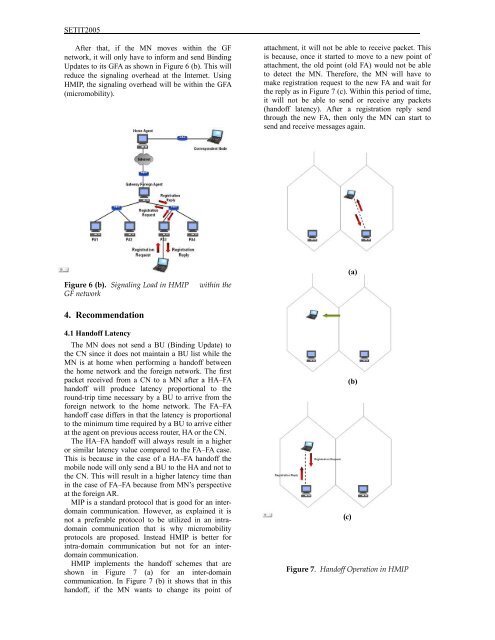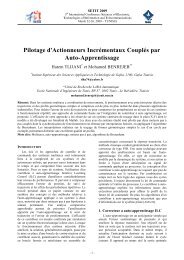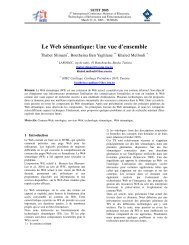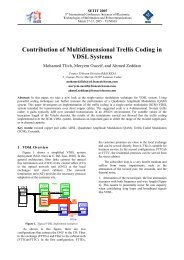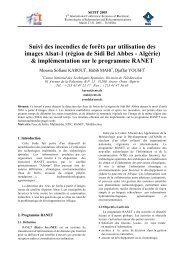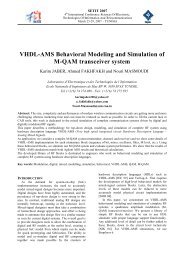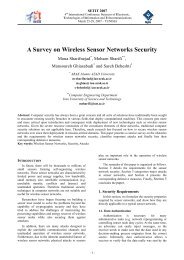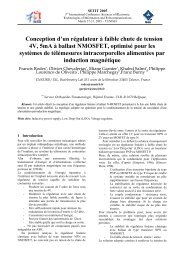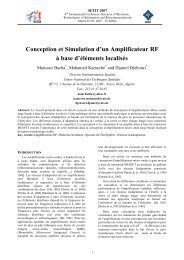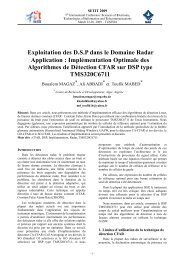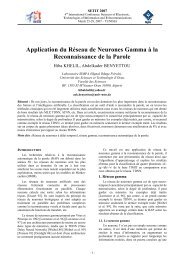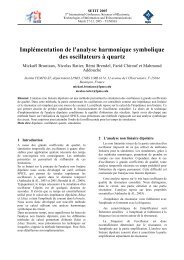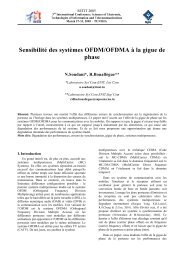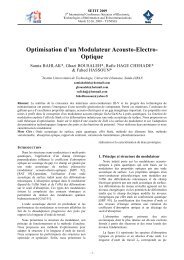Mobility Issues in Hierarchical Mobile IP
Mobility Issues in Hierarchical Mobile IP
Mobility Issues in Hierarchical Mobile IP
Create successful ePaper yourself
Turn your PDF publications into a flip-book with our unique Google optimized e-Paper software.
SETIT2005<br />
After that, if the MN moves with<strong>in</strong> the GF<br />
network, it will only have to <strong>in</strong>form and send B<strong>in</strong>d<strong>in</strong>g<br />
Updates to its GFA as shown <strong>in</strong> Figure 6 (b). This will<br />
reduce the signal<strong>in</strong>g overhead at the Internet. Us<strong>in</strong>g<br />
HM<strong>IP</strong>, the signal<strong>in</strong>g overhead will be with<strong>in</strong> the GFA<br />
(micromobility).<br />
attachment, it will not be able to receive packet. This<br />
is because, once it started to move to a new po<strong>in</strong>t of<br />
attachment, the old po<strong>in</strong>t (old FA) would not be able<br />
to detect the MN. Therefore, the MN will have to<br />
make registration request to the new FA and wait for<br />
the reply as <strong>in</strong> Figure 7 (c). With<strong>in</strong> this period of time,<br />
it will not be able to send or receive any packets<br />
(handoff latency). After a registration reply send<br />
through the new FA, then only the MN can start to<br />
send and receive messages aga<strong>in</strong>.<br />
Figure 6 (b). Signal<strong>in</strong>g Load <strong>in</strong> HM<strong>IP</strong><br />
GF network<br />
4. Recommendation<br />
with<strong>in</strong> the<br />
(a)<br />
4.1 Handoff Latency<br />
The MN does not send a BU (B<strong>in</strong>d<strong>in</strong>g Update) to<br />
the CN s<strong>in</strong>ce it does not ma<strong>in</strong>ta<strong>in</strong> a BU list while the<br />
MN is at home when perform<strong>in</strong>g a handoff between<br />
the home network and the foreign network. The first<br />
packet received from a CN to a MN after a HA–FA<br />
handoff will produce latency proportional to the<br />
round-trip time necessary by a BU to arrive from the<br />
foreign network to the home network. The FA–FA<br />
handoff case differs <strong>in</strong> that the latency is proportional<br />
to the m<strong>in</strong>imum time required by a BU to arrive either<br />
at the agent on previous access router, HA or the CN.<br />
The HA–FA handoff will always result <strong>in</strong> a higher<br />
or similar latency value compared to the FA–FA case.<br />
This is because <strong>in</strong> the case of a HA–FA handoff the<br />
mobile node will only send a BU to the HA and not to<br />
the CN. This will result <strong>in</strong> a higher latency time than<br />
<strong>in</strong> the case of FA–FA because from MN’s perspective<br />
at the foreign AR.<br />
M<strong>IP</strong> is a standard protocol that is good for an <strong>in</strong>terdoma<strong>in</strong><br />
communication. However, as expla<strong>in</strong>ed it is<br />
not a preferable protocol to be utilized <strong>in</strong> an <strong>in</strong>tradoma<strong>in</strong><br />
communication that is why micromobility<br />
protocols are proposed. Instead HM<strong>IP</strong> is better for<br />
<strong>in</strong>tra-doma<strong>in</strong> communication but not for an <strong>in</strong>terdoma<strong>in</strong><br />
communication.<br />
HM<strong>IP</strong> implements the handoff schemes that are<br />
shown <strong>in</strong> Figure 7 (a) for an <strong>in</strong>ter-doma<strong>in</strong><br />
communication. In Figure 7 (b) it shows that <strong>in</strong> this<br />
handoff, if the MN wants to change its po<strong>in</strong>t of<br />
(c)<br />
(b)<br />
Figure 7. Handoff Operation <strong>in</strong> HM<strong>IP</strong>


